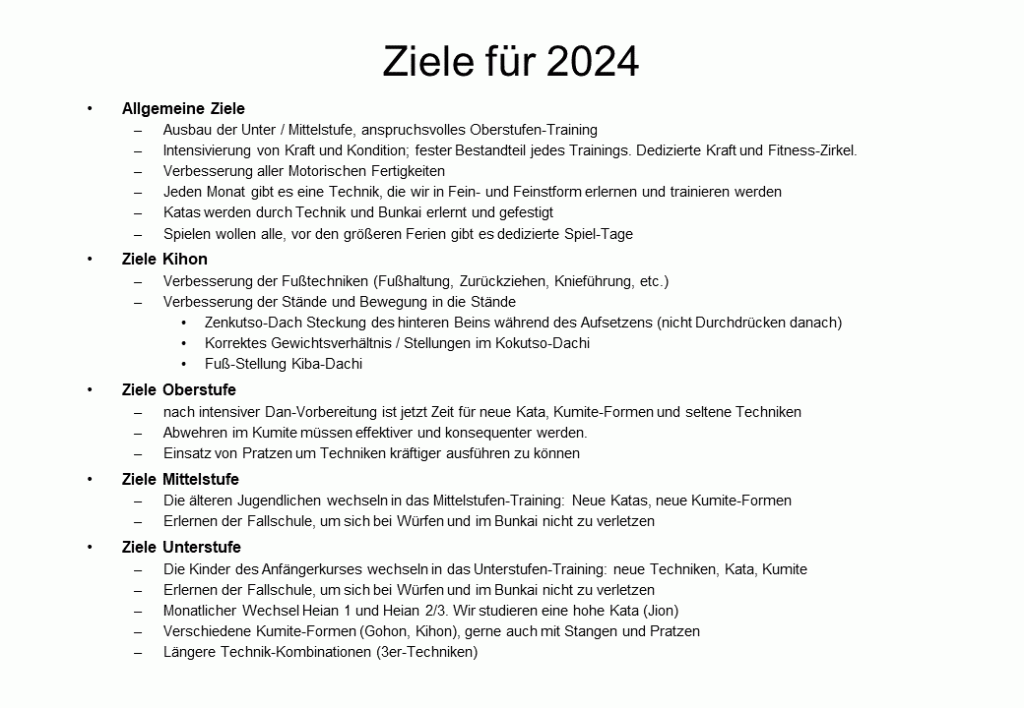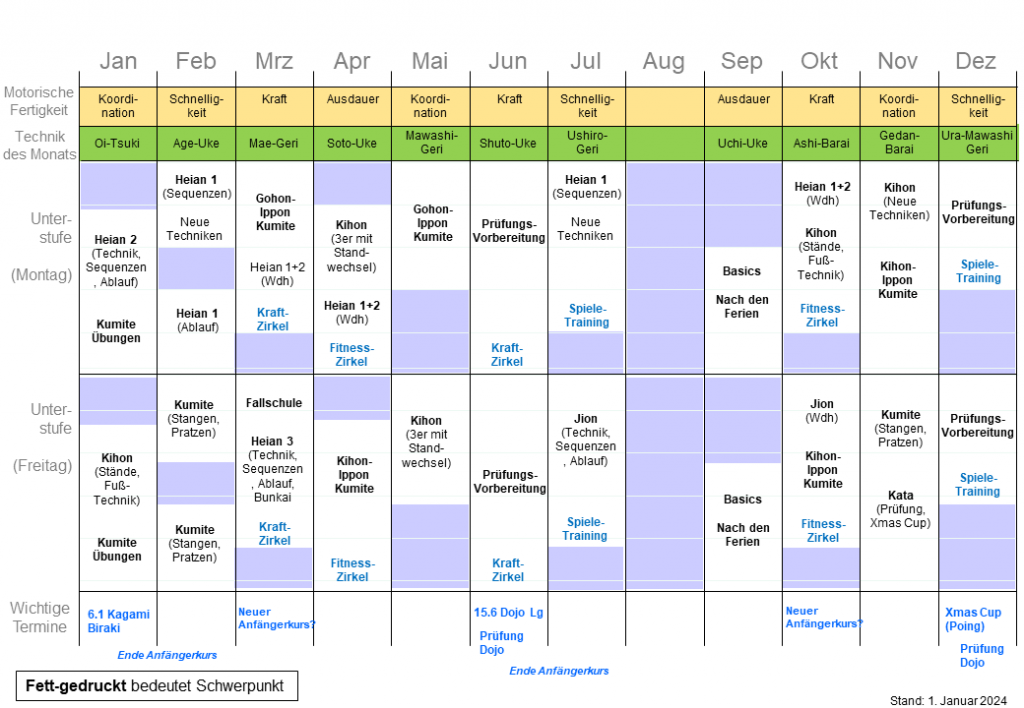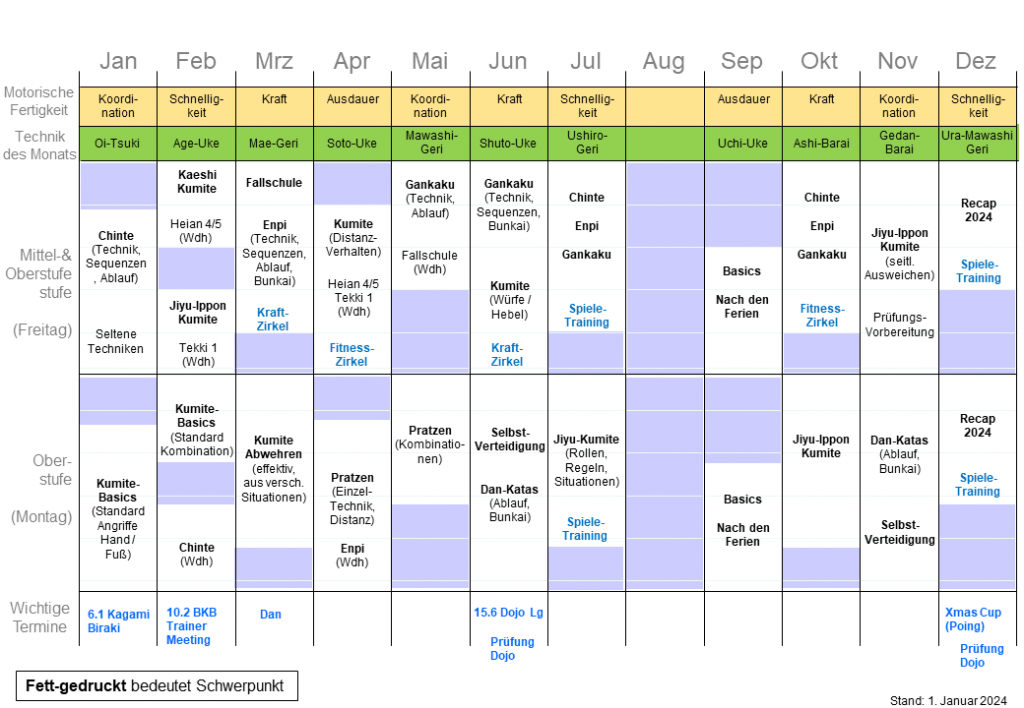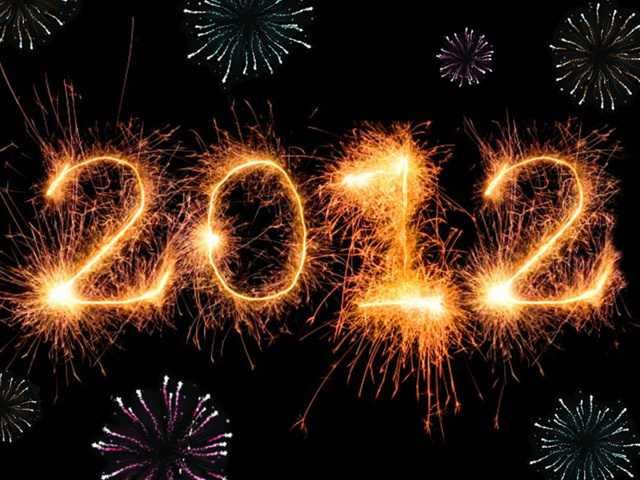Kagami Biraki 2024
ingo, um 16:28 Uhr am 13-01-2024
Das Karate Jahr 2024 fing früh an. Am 6.Januar um 6:00 Uhr morgens trafen sich 15 begeisterte Karateka zum Kagami Biraki 2024.
 |  |
Beim Kagami Biraki handelt es sich um eine alte japanische Tradition aus der Zeit der Samurai, mit der das neue Jahr begrüßt wird. Die auch als Wintertraining bekannten Übungen umfassen bei uns alle 26 Shotokan Katas, 1000 Tsukis und 1000 Mae Geris. Das Kagami Biraki stellt eine besondere Herausforderung an Durchhaltevermögen, Willensstärke und Konzentration dar, denn von der ersten bis zur letzten Technik muss mit derselben Kraft und Sauberkeit gearbeitet werden.

Trotz Dunkelheit und Kälte haben wir die Strapazen angenommen und unser Bestes gegeben. Selbst wenn die eine oder andere Kata nicht beherrscht wurde, haben alle mitgemacht. Zwischen jeder Kata wurden 40 Tsukis und 40 MaeGeris ausgeführt. Um sich gegenseitig zu motivieren kam jeder an die Reihe, für die Gruppe auf japanisch zu zählen. Abschliessend wurde die Ausführung der Techniken auf einem Zettel protokoliert.
 |  |
Nach 2 Stunden waren wir mit unserem anstrengenden Jahresauftakt-Training fertig – just in time konnten die Fußballer die Halle übernehmen. Biraki Kagami bedeutet übersetzt “Öffnen des Sakefasses” : Der Holzdeckel von dem traditionellen Sakefass (Kagami) wird während der Sakezeremonie zerbrochen (wari) bzw. geöffnet (biraki). Entsprechend der Japanischen Tradition haben wir nach dem Training mit einem Stamperl Sake auf das neue Jahr angestossen.
 |  |

Im Anschuss luden unsere erfolgreichen Dan-Prüflinge zum Weisswurst-Frühstück im Pavillon ein. Ein toller Start ins Karatejahr 2024
 |  |
Weitere Fotos gibts auf unserer FlickR Seite.
Trainer-Einteilung 2024
ingo, um 20:54 Uhr am 01-01-2024
Diese Seite enthält die Aufteilung der Trainer für die Trainingseinheiten mit Trainerpool (Montag, Freitag, Sonntag) in 2024.
Dezember 2024
02.12., Mo., Anton
06.12., Fr., Ingo
09.12., Mo., Józsi
13.12., Fr., Ingo NN
16.12., Mo., Anton
20.12., Fr., Ingo
23.12., Mo., —-( Schulferien)
27.12., Fr., ??? (freies Training)
30.12., Mo., —-( Schulferien)
November 2024
04.11., Mo., Anton
08.11., Fr., Ingo
11.11., Mo., Józsi
15.11., Fr., Rainer
18.11., Mo., Anton
22.11., Fr., Peter Thomas
25.11., Mo., Józsi
29.11., Fr. Ingo
Oktober 2024
04.10., Fr., Thomas
07.10., Mo., Józsi
11.10., Fr., (Halle belegt – Modellbahnausstellung)
14.10., Mo., Anton
18.10., Fr., Ingo
21.10., Mo., Józsi
25.10., Fr., Ingo
28.10., Mo., —- (Schulferien)
September 2024
02.09., Mo., —- (freies Tr.)
06.09., Fr., Ingo
09.09., Mo., —- (freies Tr.)
13.09., Fr., Ingo
16.09., Mo., Anton
20.09., Fr., Ingo
23.09., Mo., Józsi
27.09., Fr., Ingo
30.09., Mo., Anton
August 2024
02.08., Fr., Rainer
05.08., Mo., Józsi
09.08., Fr., Ingo
12.08., Mo., Anton
16.08., Fr., Ingo (Brückentag)
19.08., Mo., Józsi
23.08., Fr., Rainer
26.08., Mo., Anton
30.08., Fr., Ingo
Juli 2024
01.07., Mo., Józsi
05.07., Fr., Ingo
08.07., Mo., Anton
12.07., Fr., Ingo
15.07., Mo., Józsi
19.07., Fr., Ingo
22.07., Mo., Anton
26.07., Fr., Ingo
29.07., Mo., —— Sommerferien
Juni 2024
07.06., Fr., Ingo
10.06., Mo., Anton
14.06., Fr., Peter S.
17.06., Mo., Józsi
21.06., Fr., Ingo
24.06., Mo., Anton
28.06., Fr., Ingo
Mai 2024
03.05., Fr., Ingo
06.05., Mo., Anton
10.05., Fr., Rainer
13.05., Mo., Józsi
17.05., Fr., Peter
20.05., Mo., — (Pfingstmontag)
24.05., Fr., Ingo
27.05., Mo., —(Schulferien)
31.05., Fr., Ingo
April 2024
08.04., Mo., Józsi
12.04., Fr., Ingo
15.04., Mo., Anton
19.04., Fr., Ingo
22.04., Mo., Józsi
26.04., Fr., Ingo
29.04., Mo., Anton
März 2024
04.03., Mo., Ingo
08.03., Fr., Ingo
11.03., Mo., Anton Ingo
15.03., Fr., Ingo
18.03., Mo., Anton
22.03., Fr., Ingo Anton
25.03., Mo., Józsi
29.03., Fr., —– (Karfreitag)
Februar 2024
02.02., Fr., Ingo
05.02., Mo., Anton
09.02., Fr., Ingo
12.02., Mo., —- (Schulferien)
16.02., Fr., Rainer (Schulferien)
19.02., Mo., Anton
23.02., Fr., Ingo
26.02., Mo., Józsi
Januar 2024
5.01., Fr., Michaela
8.01., Mo., ??
12.01., Fr., Ingo
15.01., Mo., ??
19.01., Fr., Ingo
22.01., Mo., ??
26.01., Fr., Ingo
29.01., Mo., ??
Trainingsplan 2024
ingo, um 20:28 Uhr am
Liebe Karateka,
Vielen Dank für Euren Input zu den Trainingszielen in diesem Jahr. Der Trainerstab des Dojo hat gerade den Trainingsplan für das Jahr 2024 fertiggestellt. Wir können so einen roten Faden über Trainingseinheiten und Trainer hinweg sicherstellen, insbesondere aber auch die Trainings untereinander abstimmen und koordinieren. Basierend auf diesem Rahmentrainingsplan planen die Trainer dann ihre einzelnen Trainingseinheiten.
Aber auch für die Sportler ist der Trainingsplan wertvoll. Ihr könnt Euch auf das Training einstimmen, zum Beispiel ob der Fokus auf Kata oder Kumite liegt. Manche unter Euch schauen sich zum Beispiel basierend auf dem Trainingsplan die Katas zuvor auf YouTube an oder lesen diese in den Büchern nach, um für das Training bereits vorbereitet zu sein. Die Gefahr, dass sich Sportler die „Rosinen“ rauspicken und andere Trainings vermeiden, sehen wir nicht. Karate lebt ja von der Vielfalt, sei es Kihon, Kumite, Kata, Bunkai, oder Selbstverteidigung.
Im Trainingsplan seht ihr einen Punkt Motorische Fertigkeiten. Hier werden wir jeden Monat einen Aspekt – Kondition/Ausdauer, Koordination, Schnelligkeit, oder Kraft – speziell trainieren. Hier sind die Trainer gefragt, sich schöne Übungen zu überlegen, die dann hoffentlich auch etwas mit Karate zu tun haben.
Neu dazugekommen ist der Punkt Technik des Monats. Hier werden wir jeden Monat eine Technik intensiv erlernen und verbessern. Von der Grundform zur Feinform bis zur Feinstform. Die Trainer werden sich selbst intensiv mit der Technik auseinandersetzen, und dieses Wissen dann an Euch weitergeben. Wir sind gespannt, was die Trainer hieraus machen und wie es bei Euch ankommt.
Hinweis: Die geschlossene Kindergruppe am Mittwoch sowie die Jukurengruppen am Donnerstag haben ihre eigenen Trainingspläne und sind hier nicht aufgeführt.
Allgemeine Ziele
Allgemeine Ziele
- Ausbau der Unter / Mittelstufe, anspruchsvolles Oberstufen-Training.
Intensivierung von Kraft und Kondition; fester Bestandteil jedes Trainings. Dedizierte Kraft und Fitness-Zirkel, bei dem wir mit Spass und Musik 1x im Monat powern. - Verbesserung aller Motorischen Fertigkeiten.
- Jeden Monat gibt es eine Technik, die wir in Fein- und Feinstform erlernen und trainieren werden.
- Katas werden durch Technik und Technik-Sequenzen erlernt und gefestigt. Das Verständnis der Technik erfolgt durch Bunkai.
- Spielen wollen alle, vor den größeren Ferien gibt es dedizierte Spiel-Tage .
Ziele Kihon
- Verbesserung der Fußtechniken (Fußhaltung, Zurückziehen, Knieführung, etc.)
- Verbesserung der Stände und Bewegung in die Stände
- Zenkutso-Dach Steckung des hinteren Beins während des Aufsetzens (nicht Durchdrücken danach)
- Korrektes Gewichtsverhältnis / Stellungen im Kokutso-Dachi
- Fuß-Stellung Kiba-Dachi
Trainingsplan Unterstufe
Ziele Unterstufe
- Die Kinder des Anfängerkurses wechseln in das Unterstufen-Training: neue Techniken, Kata, Kumite.
- Erlernen der Fallschule, um sich bei Würfen und im Bunkai nicht zu verletzen.
- Monatlicher Wechsel Heian 1 und Heian 2/3.
- Wir studieren eine hohe Kata (Jion), denn wir sind überzeugt, dass die Kinder das können und daran Spaß haben.
- Verschiedene Kumite-Formen (Gohon, Kihon), gerne auch mit Stangen und Pratzen
- Längere Technik-Kombinationen (3er-Techniken), am besten mit Wechsel der Stellungen (Zenkutso-Dachi, Kokutso-Dachi, Kiba-Dachi)..
- Ende des Jahres werden wir den XMas-Cup ausrichten. Hieran nehmen möglichst viele Kinder teil.
Trainingsplan Mittelstufe / Oberstufe
Ziele Mittelstufe
- Die älteren Jugendlichen wechseln in das Mittelstufen-Training: Neue Katas, neue Kumite-Formen. Aber auch die Katas für die nächste Prüfung werden studiert.
- Erlernen der Fallschule, um sich bei Würfen und im Bunkai nicht zu verletzen.
- Die Mittelstufe profitiert von der Oberstufe: Neue Katas werden erlernt.
Ziele Oberstufe
- nach der intensiven Dan-Vorbereitung in 2023 ist jetzt Zeit für neue Kata (Chinte, Gangaku), Kumite-Formen und seltene Techniken.
- Abwehren im Kumite müssen effektiver und konsequenter werden. Wir betonen im Kumite die Verteidigung, nicht den Angriff, entsprechend dem Motto Karate ni sente nashi
- Einsatz von Pratzen um Techniken kräftiger ausführen zu können.
JKA Teaching Guidelines
ingo, um 14:10 Uhr am 29-09-2022
Hier eine Kopie der Teaching Guidelines der JKA (Quelle: JKA Teaching Guidelines). Hilfreich für alle Trainer, aber eben auch alle Karateka – insb. Dan-Prüflinge – , denn es zeigt ganz gut, was an von einem reifen Karateka erwartet wird.
Instructor’s proficiency
- The Japan Karate Shoto Federation Instructors shall be highly conscience of their work and handle their duties with pride.
- The creed of “No first attack in Karate” should be engraved in everyone’s heart.
- Transform everything in your daily life into the way of karate.
- Dedicate yourself to study the way (path) more than to mastering of the skills.
- Always be demanding to yourself and actively strive forward.
- The instructor should possess qualities needed to become a role model (example) to the students which should foster their morality without the need for enforcement.
- Explore yourself high and deep to develop an overall concept.
- The instructor should not force others to follow his way of thinking, leave his selfishness behind, show persistence and work together with his colleagues for successful promotion of Karate-do.
Teaching guidelines
- Teaching should be held with courtesy, moderation and sincerity.
- Teach not with haste but with patience and care.
- Do not build emotional preferences to any particular individual.
- Avoid uniform teaching. Teaching methods should differ according to student’s age, gender, strength level or other conditions.
- Intensive trainings for athletes and instructors and basic trainings for average karate practitioners should be held separately.
- Instead of pointing out only students’ mistakes, explain what they should do to avoid or correct them.
- Do not mix up technique teaching with body conditioning, instead properly separate and combine them while training.
- Do not force students to train according to your personal habits; instead teach according to the ideal image.
- Do not be too dedicated only to Kihon, Kata or Kumite, instead divide the training time properly, and sometimes teach self-defense skills.
Teaching Kihon
- Develop karate skills gradually, from simple techniques to complicated ones, depending upon students’ progress.
- Do not confuse the aims of techniques during application beyond the level of ability.
- Apply a scientific approach to the teaching of Kihon. Analyze its physical and physiological aspects.
- Correct posture, solid stances and footwork should be performed easily and smoothly.
- Hip rotation should be fast and at the same time horizontal towards the ground.
- Pay attention to correct technique trajectory, acceleration and the concentration power.
- Ensure to have correct elbow positioning while blocking techniques execution.
- Grasp the target level precisely whether it is jodan, chudan or gedan.
- Know your own technique range and distance properly. Be careful not to break your form trying to extend the techniques’ range.
Teaching Kata
- Understanding of Kata should not be limited only to physical exercise.
- Kata is an original Japanese martial art training method based on valuable experience, which evolved from exquisite and realistic practice of our ancestors on the battlefield in life or death situations.
- Kata, like Go or Shogi, requires the deep study of fighting strategy to progress.
- Kata begins with Rei (courtesy) and ends with Rei (courtesy).
- Kata is not merely a set of basic techniques. From the beginning to the end it flows as an integral whole where every technique has its own characteristics.
- Do not change Kata basic techniques according to your preference, but keep their performance to Kihon requirements.
- Always clearly keep in mind three factors: correct use of power, speed and the correct expansion and contraction of the body.
- Perform Kata accurately according to Embusen (performance line).
- Technique and breathing should be simultaneous. Successive techniques should be performed in one breath.
- Each kata has a specific number of movements to be performed in defined order and in standard performance time.
- Pay attention to a technique’s correct application, to the appropriate state of mind and spirit, and to the correct performance of Kiai. It should be produced shortly and sharply directed from the lower abdomen.
- Use hip rotation to sharply perform changes of technique direction. Thrust your pivot leg strongly against the floor to perform swift and smooth body shifting.
- Techniques shall be performed at the same time the body movement shifts.
- Clearly understand special characteristics of Kata under study as well as the meaning of each movement.
- Understand the relation between preceding and following techniques.
- When moving from one technique to the other, avoid any unnecessary motions.
- Diligently repeat parts of Kata as necessary.
- Teach the rhythm of Kata through counting.
Teaching Kumite
- Different types of Kumite should be taught properly depending on progress.
- All types of Kumite should be well understood and their practice purposes should be clearly grasped.
Gohon Kumite
- Its main purpose is to drill Karate basic techniques of offence and defense, learning how to punch and kick by using Unsoku (body shifting) and to defend against them alternately.
- Advanced practitioners should practice swift and daring attacks, body evasions combined with blocking techniques.
Gohon Kumite
- It shall be used to attain proficiency in powerful basic skills of offense and defense.
- The connection between blocking and focus (Kime) shall be of the utmost important here.
- Make use of fixed distance to learn personal attacking and blocking distance for a decisive counter-attack.
- Effective blocking distance and posture should be followed by an instant and properly chosen decisive attack and finishing technique when countering the attacker’s action.
- For good successive defense timing, assess the opponent’s movement, wait until the last moment, then swiftly and sharply block the attack.
- Use various stances for resisting an opponent’s attack.
Jiyu Ippon Kumite
- It is a preliminary transitional step to Jyu Kumite, free sparring, the ultimate objective of Karate.
- It allows mastering the use of optimal distance of practical offence and defense and to block and counter-attack in a single breath.
- It allows effective situational awareness of offensive and defensive techniques.
- It is required to master effective ways of counter-attacking and powerful finishing techniques, as well as body-shifting, body-evasions and technique changing methods.
Jiyu Kumite
- It deals with methods of creating situations for effective attack and defense from random distance. It shall be utilized to study the ways of distance variation used to invite or trap the opponent in your counter-attack; as well as to study the effective attacking distances of your opponent.
- Master kake and kuzushi
- Study how to create an opening for technique implementation and how not to miss a chance for attack.
- Thoroughly practice changing techniques and technique combinations.
- Master the sudden change from defense to offence
- Actively use tactics of seizing the initiative earlier (Sen no sen) and seizing the initiative later (Go no sen).
- Use various feints.
- Devote yourself to training seriously.
Training in der neuen Halle
ingo, um 19:15 Uhr am 02-10-2012
Liebe Eltern, liebe Sportler,
endlich ist es soweit. Wir wechseln ab 8. Oktober die Halle am Montag. Dazu die neuen Daten.
Ort: Dreifachturnhalle der Realschule
Kinder: 18.00 -19.30 Uhr
Erwachsene: 19.30-21.00 Uhr
Da wir die Halle noch nicht kennen, es immer noch zu Änderungen zwischen Halle A, B und C kommt und wir noch nicht wissen, wie die Schließanlage funktioniert, kommen die Trainer zum Eingang und holen euch ab bzw. sperren die Türe auf. Bitte nicht gleich wieder nach Hause gehen, sollte die Türe noch geschlossen sein.
Für alle Wettkampfkinder: Ab 11.Oktober findet immer Donnerstags das Fördertraining in der neuen Halle statt.
Ort: Dreifachturnhalle der Realschule
Zeit: 18.00-19.00 bzw. 19.30 Uhr, die Einteilung in die Gruppen findet im ersten Training statt.
Ich wünsche allen viel Spaß in der neuen Halle und vorallem ein verletzungsfreies Training.
Karate Dojo Poing auf einer größeren Karte anzeigen
Link auf Google Maps: Link
viele Grüße
Kathleen Averdunk
Neue Zeiten / Aufteilung im Freitags-Training
ingo, um 13:40 Uhr am 04-04-2012
Hallo,
Freitags haben wir das Problem, dass eine Menge Kinder und ein paar Erwachsene im gleichen Training trainieren. In dieser Situation können wir nur schlecht ein altersgerechtes Training für beide Gruppen anbieten. Das wurde auch bei der Dojo-Umfage in Eurem Feedback angesprochen. Daher werden wir nach den Osterferien das erste Training teilen: eine Gruppe Kinder und eine Gruppe Erwachsene. Uwe hat sich bereit erklärt, als zweiter fester Trainer zu agieren; ab und zu stehen Thomas, Rainer und Peter als Ersatztrainer zur Verfügung. Das Modell macht natürlich nur dann Sinn, wenn wir auch genügend Erwachsene sind (denn für 2 Personen werden wir kein extra Training anbieten). Wir werden diesen Modus bis zu den Sommerferien ausprobieren und entscheiden dann, ob wir so weitermachen und somit ein zweites Training für die Jukurengruppe anbieten.
Gleichzeitig ziehen wir das Training wie jeden Sommer wieder 30min vor.
Somit lauten die neuen Trainingszeiten am Freitag (ab 20.April).
18:00 – 19:00
Kinder-Training (bis 14J) bis Grüngurt (DFH, Sektion C)
Erwachsenen-Training bis Grüngurt (DFH, Sektion B)
18:30 – 19:00
freies (bzgl. angeleitetes) Aufwärmtraining und Dehnen (DFH, Sektion B)
19:00 – 20:00
Training ab Grüngurt (DFH, Sektion C)
(Grüngurte können sich entscheiden, an welchem Training sie teilnehmen wollen)
ingo
Ein frohes neues Jahr
ingo, um 15:04 Uhr am 01-01-2012
Yoi otoshiwo (“Wir sehen uns nicht mehr in diesem Jahr, Ihnen ein gutes Neues!”)
Pünktlich zu Gantan (“erster Morgen”) wünschen wir allen Karateka ein glückliches, verletzungsfreies und erfolgreiches Jahr 2012. Sicher habt ihr Euch für das neue Jahr auch sportliche Ziele gesetzt, sei es eine Gürtelprüfung, die Teilnahme an Meisterschaften oder einfach nur allgemeine Fitnes (und Gewichtsreduktion).
Aber ihr wisst ja: Euer größter Gegner seid ihr selbst !
In diesem Sinne auf ein gutes Jahr 2012.
ingo
Und hier noch ein paar Links für die Japan-Interessierten unter Euch:
Training in den Herbstferien
ingo, um 07:10 Uhr am 31-10-2011
Hallo zusammen,
Während der Herbstferien findet das Training nur am Freitag 4.November statt (18:00-19:00 Unterstufe, 18:30-20:00 Mittel/Oberstufe).
Im Winter sind die Fußballer wieder in der Turnhalle und wir müssen damit rechnen, dass sich das Freitags-Training wieder um 30Minuten nach hinten verschiebt. Ich habe allerdings noch keine Information, ab wann die Fußballe in der Halle trainieren. Rechnet also bitte damit, dass in den nächsten Wochen das Training 30min später Enden könnte,
ingo







